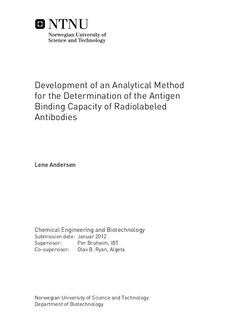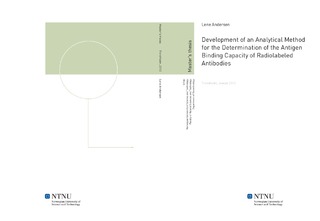| dc.description.abstract | The foundation of Algeta's second alpha-pharmaceutical platform is thorium-227, a radionuclide that emits alpha particles with high energy. By linking thorium-227 to tumor binding monoclonal antibodies, Algeta has the potential to develop a new generation of radioactive drugs that can fight cancer with limited damage to surrounding tissue. Determination of the immunoreactive fraction (IRF) of these molecules is an important part of the quality control of such a product. IRF is determined by examination of the tumor-binding molecule's ability to bind to antigens on the surface of living or fixated cells. This is a labor-intensive method in which a large number of cells must be cultivated and fixated prior to the analysis. It is therefore desirable to develop an immunoreactivity assay independent of cells.
The Lindmo method is a widely used method for the determination of IRF. The method used by Algeta today is a simplification of the Lindmo method, in this report called the one-point assay. This is a timesaving method, but there are uncertainties about the reliability its results. A part of this project was to examine if the one-point analysis can be used as a timesaving alternative to the Lindmo assay. The conclusion was that a full Lindmo assay should be performed whenever a new system is investigated, or whenever high accuracy is required. However, the one-point analysis is a timesaving method that can be used to estimate IRF in a routine quality check.
Microbeads coated with antigen might have a potential to substitute cells in these assays. The main objective of this project was to develop a quantitative bead-based method adapted to the tumor-binding systems used by Algeta, and to perform a comparison study between the cell- and bead-based methods. The results demonstrated that antigen-coated beads with advantage can be used as a substitute for cells. The bead-based assays were timesaving, demonstrated a high degree of reproducibility and provided more consistent and reliable results than the cell-based measurements. The bead-based assays have the potential to be used for any antibody-antigen systems where the antigen or the epitope of the antigen can be isolated. | |

